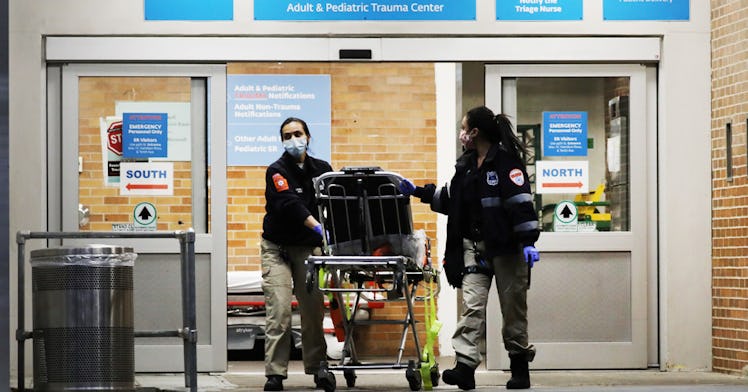COVID-19 Cases Up, But Deaths Are Down. Here’s Why
There are a lot of factors.

COVID-19 cases in the U.S. broke records with a one-day high on Thursday of 39,972 new cases. But even with thirty-two states seeing an increase in cases and hot-spot states like Arizona and Texas experiencing extreme spikes, there’s another hidden truth in these alarming numbers. Overall, as of this writing, deaths are down.
Of all deaths in the U.S., only 7.1% were due to COVID-19, flu, and pneumonia for the week ending June 13. That’s down from 11.4% from the previous week, according to the Centers for Disease Control. Total numbers of deaths are increasing too. Two weeks ago, COVID-19 deaths nationwide were down to about 680 a day compared to 980 a day compared to two weeks prior, according to an analysis from the Associated Press. So why are deaths on the decline?
Deaths are down. But maybe only for now.
An important point to keep in mind is that it takes time before people infected with the coronavirus get sick enough to die. “Deaths always lag considerably behind cases,” Anthony Fauci, the nation’s top infectious disease specialist, said at a congressional hearing last week. A month ago, there were fewer COVID-19 cases per day, so death rates now could be reflecting those numbers. Some experts expect death rates will rise over the next month to reflect the current surge in cases, according to the Washington Post.
But there are other explanations for the low number of deaths. One of the biggest reasons is that many people who are getting sick now are young — and yes, you probably count as young by this definition. More people in their 20s, 30s, and 40s are blowing off social distancing guidelines because they now know they’re less likely to get severely sick from the disease. In Florida, for example, the median age of COVID-19 patients is 35, according to the New York Times. In March, it was 65.
More young people are testing positive.
When young people do catch COVID-19, cases go up, but deaths don’t go up. “They’re more likely to recover,” says Parameswaran Hari, a professor of hematology at the Medical College of Wisconsin. “In countries like Brazil where there is a substantially younger population than our own, although they have a large number of cases, their mortality is relatively low,” Hari says. In the U.S., this may not stay the case forever. Young people don’t exist in a vacuum. They will eventually infect older people, and the death rate will rise again.
Doctors have also gotten better at handling the disease. Though they haven’t developed a vaccine or any miracle drugs, they do have a better understanding of how to treat COVID-19 patients that are severely ill. For example, the drug remdesivir can lessen symptoms and decrease the amount of time someone is sick with COVID-19. Researchers recently announced that the common drug dexamethasone reduces COVID-19 deaths, though full data has not been published yet. Doctors may give patients blood transfusions from people with antibodies to help them recover. They have also discovered non-invasive ways to help patients, including placing them in a prone position to help them breathe when not on a ventilator.
Hospitals are also emptier and better equipped to deal with the pandemic. In the beginning, many were overflowing with patients. And though ICUs are filling up in some parts of Texas and Mississippi, many more have room to take in the severely ill. “Hospitals are not getting overwhelmed like they were in the beginning,” Hari says. More may fill up as cases continue to rise.
The future is still happening.
So don’t celebrate the dropping death rate just yet. The only way to tell if deaths will stay low or if they’ll spike is to wait. In the meantime, wearing a mask and social distancing is the best way to keep that number low.
This article was originally published on